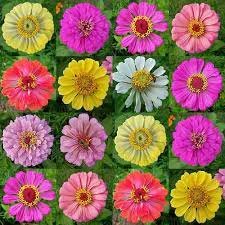**Distinguishing Between Chrysanthemums and Other Wildflowers**

Chrysanthemums, with their iconic blooms and rich cultural history, are often mistaken for other wildflowers due to their similar appearance. However, several key features can help distinguish chrysanthemums from other wildflower species. Understanding these differences is essential for accurately identifying chrysanthemums and appreciating their unique beauty and characteristics. Let’s explore how to differentiate between chrysanthemums and other wildflowers based on various criteria.
**1. Flower Structure:**
Chrysanthemums are characterized by their distinctive flower structure, which typically consists of multiple layers of petals arranged in a compact, dome-shaped inflorescence. The center of the flower often contains disk florets surrounded by ray florets, giving it a classic daisy-like appearance. In contrast, many wildflowers have simpler flower structures with fewer petals or a different arrangement of reproductive organs, such as a single central disk or a cluster of tiny florets.
**2. Leaf Shape and Arrangement:**
Chrysanthemum leaves are usually lanceolate or ovate in shape, with serrated edges and a prominent midrib. The leaves are arranged alternately along the stem and may vary in size depending on the cultivar. In contrast, wildflowers exhibit a wide range of leaf shapes and arrangements, including simple, lobed, or compound leaves arranged in various patterns such as basal rosettes or opposite pairs.
**3. Growth Habit:**
Chrysanthemums are herbaceous perennial plants that typically grow from a central crown or basal rosette of leaves. They produce multiple stems that emerge from the base and develop into flowering shoots. Chrysanthemums can vary in height depending on the cultivar, ranging from compact mounds to tall, upright plants. In contrast, wildflowers exhibit diverse growth habits, including annuals, biennials, and perennials, with varying degrees of branching and stem architecture.
**4. Flower Color and Size:**
Chrysanthemums are renowned for their diverse range of flower colors, including white, yellow, pink, purple, red, and orange, among others. The flowers may be single-colored or bi-colored, and some cultivars exhibit intricate patterns or variegation. Additionally, chrysanthemum flowers can vary widely in size, ranging from small, dainty blooms to large, showy inflorescences. In contrast, wildflowers come in a multitude of colors and sizes, with each species exhibiting its own unique floral characteristics.
**5. Cultivation and Origin:**
Chrysanthemums are commonly cultivated as ornamental plants in gardens, parks, and floral arrangements worldwide. They have been selectively bred for centuries to produce a wide range of cultivars with diverse flower forms, colors, and growth habits. While some wildflowers may also be cultivated for ornamental purposes, they are typically found growing in their native habitats and have not undergone extensive breeding or hybridization like chrysanthemums.
**6. Cultural Significance:**
Chrysanthemums hold significant cultural symbolism in many societies, particularly in East Asia, where they are revered as symbols of longevity, happiness, and prosperity. Chrysanthemum festivals and exhibitions are held annually to celebrate these revered flowers and their cultural heritage. In contrast, wildflowers may have cultural significance in their native regions but are not typically associated with the same level of cultural symbolism and tradition as chrysanthemums.
**Conclusion:**
While chrysanthemums may share certain characteristics with other wildflowers, several key features distinguish them from other species. By examining the flower structure, leaf morphology, growth habit, flower color and size, cultivation history, and cultural significance, it becomes easier to differentiate chrysanthemums from other wildflower species. Understanding these distinctions allows for a deeper appreciation of chrysanthemums and their unique place in the botanical world.
**7. Habitat and Ecological Role:**
Chrysanthemums, as cultivated ornamental plants, are often found in human-managed environments such as gardens, parks, and floral arrangements. They thrive in well-drained soil with ample sunlight and are commonly grown for their aesthetic appeal. In contrast, wildflowers inhabit a wide range of natural habitats, including grasslands, woodlands, meadows, and wetlands. They play important ecological roles as pollinator attractors, soil stabilizers, and wildlife food sources. Unlike chrysanthemums, which are primarily valued for their decorative value, wildflowers contribute to ecosystem diversity and resilience.
**8. Life Cycle and Reproduction:**
Chrysanthemums are herbaceous perennial plants, meaning they live for multiple years and undergo dormant periods during winter before regrowing in the spring. They reproduce through seeds, cuttings, or division of root clumps. Cultivated chrysanthemums may have been selectively bred for specific traits, such as flower color, size, and form. In contrast, wildflowers have diverse life cycles, including annuals, biennials, and perennials. They reproduce through seeds, which are dispersed by wind, water, animals, or other means. Wildflowers may exhibit adaptations to their specific habitats and reproductive strategies suited to their environment.
**9. Genetic Diversity and Adaptation:**
Cultivated chrysanthemums have undergone extensive breeding and hybridization to produce a wide range of cultivars with diverse flower forms, colors, and growth habits. These cultivars may have limited genetic diversity compared to their wild counterparts, as they have been selected for specific ornamental traits. In contrast, wildflowers possess high levels of genetic diversity and may exhibit adaptations to local environmental conditions, such as drought tolerance, disease resistance, and pollinator preferences. This genetic diversity allows wildflowers to thrive in a variety of habitats and withstand environmental challenges.
**10. Cultural Significance and Symbolism:**
Chrysanthemums hold cultural significance in many societies, particularly in East Asia, where they are revered as symbols of longevity, happiness, and prosperity. Chrysanthemum festivals and exhibitions are held annually to celebrate these revered flowers and their cultural heritage. In contrast, wildflowers may have cultural significance in their native regions but are not typically associated with the same level of cultural symbolism and tradition as chrysanthemums. They may, however, hold significance for indigenous cultures or have historical uses in herbal medicine, food, or crafts.
**Conclusion:**
While chrysanthemums and wildflowers may share certain similarities in appearance, several key differences distinguish them in terms of habitat, life cycle, genetic diversity, cultural significance, and ecological role. By understanding these distinctions, individuals can better appreciate the unique characteristics and contributions of both chrysanthemums and wildflowers to the natural world. Whether adorning gardens or gracing natural landscapes, these diverse floral species each have their own story to tell and enrich our lives in their own unique ways.

